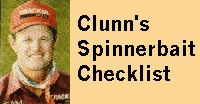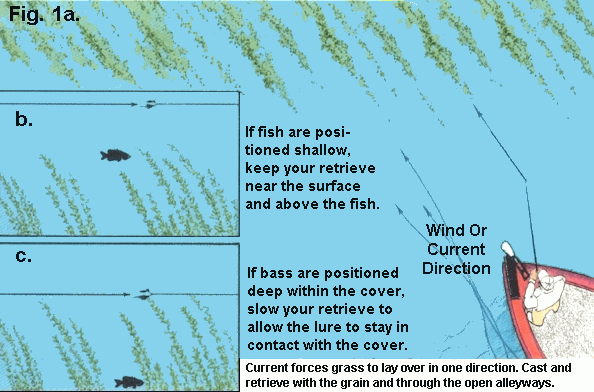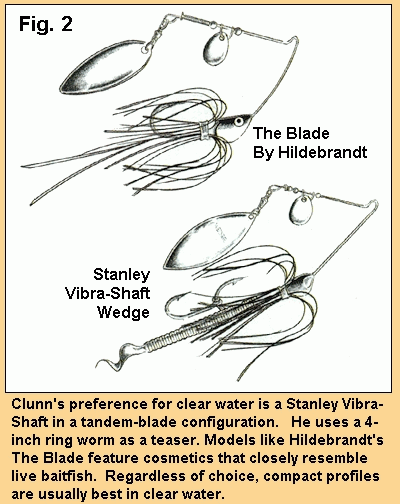Most bass anglers consider spinnerbaits and clear water a contradiction of
terms. But Rick Clunn, somewhat of a rogue on the Bassmaster® tour, sees
them as an opportunity to further distance himself from the rest of the
competitive field.
The four-time BASS Masters Classic® champ
has utilized spinnerbaits in extreme clear-water conditions to win several
major titles. The list includes the U.S. Open, the Red Man All American, the
Classic, and, most recently, the 1992 New York BASSMASTER® Invitational,
which he won with a huge creel of smallmouths in the clear waters of Lake
Ontario.
Throughout his career, Clunn has applied
his clear-water spinnerbait tactics under a wide variety of conditions and
geographic range. From the deep reservoirs of the desert southwest to the
dishpan lakes of Florida, and north to the rivers and lakes along the
Canadian border, the technique seems to have no boundaries.
Largemouth, smallmouth, and spotted bass all respond well to his strategies. Even
though cover types may vary according to habitat, how the different species react to
his presentation remains very consistent.
|
|
"The common denominator is wind," explains
Clunn. "Wind creates water movement and surface chop, which in turn brings fish up,
holding them in the shallows where they are more accessible with a spinnerbait."
Although Clunn agrees that many lures and techniques
can work under windy, clear-water conditions, none seem to be as efficient as a
spinnerbait. Not only does this lure cover large amounts of water quickly, it adds the
possibility of provoking bass that are not very aggressive. This is a major plus
when bass are reluctant to bite because of heavy fishing pressure or for
other reasons, Clunn says.
Spinnerbaits are also good big-fish lures, and for Clunn,
that's money in the bank.
Just as wind is sometimes essential for success, so too is
lure selection. Clunn's primary choice for clear water is a Stanley Vibra-Shaft in a
tandem-blade configur- ation - consisting of a leading Colorado (No. 2 or No. 3),
followed by a larger Wedge (No. 3 to No. 4 1/2) willowleaf. One gold, the other silver.
Clunn feels this combination provides a compact profile
and best suits his frequent
|
|
need for speed. Sizes range from 1/8 to 1/2 ounce, depending on
depth, cover, season, and even species of bass.
Though there are exceptions, Clunn takes a seasonal approach to blade size and lure
weight. In the spring, he believes, larger sizes might intimidate territorial spawners.
Throughout summer, Clunn uses smaller lures to accurately match adolescent forage. By fall,
he resumes with larger offerings that represent maturing baitfish.
Coloration, too, is important. Clunn says the subtle, more transparent silicone skirts
containing gold, silver, or black flake best represent the reflective scales of live baitfish.
Clunn always uses a soft plastic trailer. His preference is a 4-inch ring worm in a clear-firecracker
with a chartreuse curled tail. If he requires a trailer hook, Clunn first attaches the
ring worm to the lure, then the trailer hook. He wants the trailer hook to swing
freely at approximately half the length of the plastic trailer. (See Fig. 2.)
The overall package is built for speed, and according to Clunn, in most cases, speed is
what makes these lures productive in clear water.
|


![]() Send e-mail to bernie@bernieschultzfishing.com with questions or comments about this web
site.
Send e-mail to bernie@bernieschultzfishing.com with questions or comments about this web
site.
